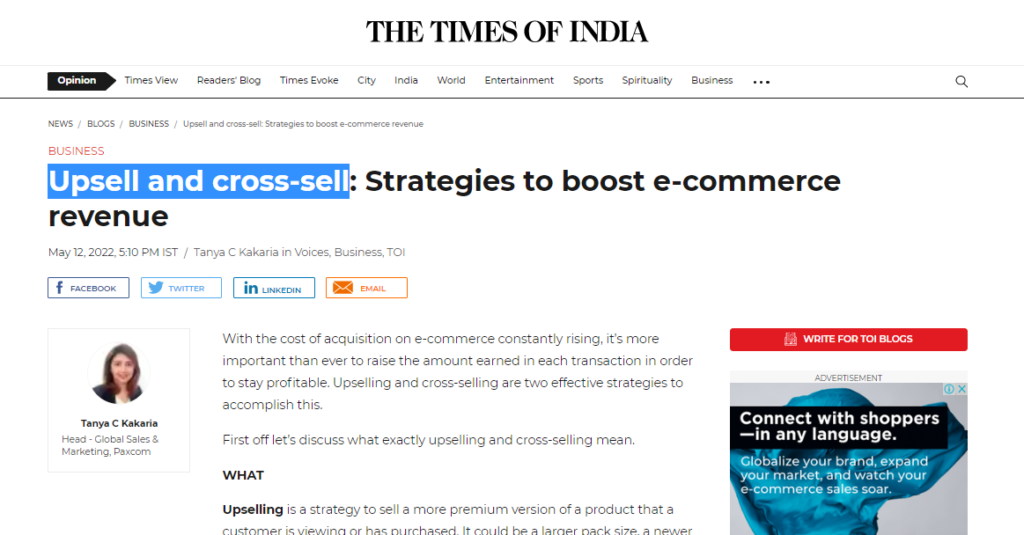
Upsell and cross-sell: Strategies to boost e-commerce revenue
With the cost of acquisition on e-commerce constantly rising, it’s more important than ever to raise the amount earned in each transaction in order to stay profitable. Upselling and cross-selling are two effective strategies to accomplish this.
First off let’s discuss what exactly upselling and cross-selling mean.
WHAT
Upselling is a strategy to sell a more premium version of a product that a customer is viewing or has purchased. It could be a larger pack size, a newer model or a product in the same category with superior features often at a higher price.
Cross-selling on the other hand, is a technique to sell a complementary or related product to the customer. For example a conditioner to someone purchases a shampoo.
WHY
Both these strategies help increase the average order value or cart value of a transaction leading to better return on acquisition costs and profitability metrics for a brand.
A large number of customers today begin their product discovery and research journey directly on ecommerce websites. Educating a customer about a product that could better suit their needs, or make their existing purchase more effective, is an important step in easing the journey from research to purchase for them. This leads to a more satisfying experience for a customer if done with the intent to help the customer win and aid them to make the right choice.
Upselling and cross-selling are also great ways to show a consumer your whole range of products, including higher-margin items and those they may not be aware you sell.
HOW
e-commerce today provides us multiple touch-points and avenues to achieve this.
Range and Regime: Introducing a related range of products as a part of your product content informs a client of other options that they may want to consider, and increases the chances of limiting product research to options within your own brand. An excellent example of this is to showcase a skincare regime comprising multiple products to Cleanse, Tone and Moisturize. Or to showcase a seasonal or theme-based collection in home linen. This can be done as a part of your brand store, product display page or even your advertising campaigns.
Brand Store: An e-commerce site allows you to create a store-in-store for your brand. Customers can use it as a single window to interact with the brand and traverse their complete product range. Having all of your products in one location allows you to upsell and cross-sell while also making it simple for customers to find what they’re looking for. Sub-categories can be used to segment the data. While rich content can engage the consumer, and support better conversion. Linkup tags can also be used to attract more consumers from different social media platforms.
Bundles and combos: Customers online are typically inundated with a barrage of choices and options that often end up complicating their purchase process. Bundling related products together through combos is an effective way to reduce the complexity of the customer’s decision making process and reduce the steps involved. It is also possible to offer better discounts and coupons on bundles than it is on individual products. Customers will be more likely to purchase a bundle if the price is lower than the sum of the individual items.
Bulk packs: Another option is to provide multipacks or larger sized packs. This strategy is best aimed at regular purchasers or returning customers, who have already tested the product and trust it. The pack size should be in line with typical usage patterns of your product or past purchase behavior of the customers. For example, a bulk pack of 168 diapers at a discount makes sense, but the same may not be effective on a product that’s quickly perishable or used occasionally. Discounts on these can also gain visibility within the Deals section
Superior alternative: When a customer is looking into a particular product, a higher-end version of that product can be offered to them as an alternative. This can be done by promoting the superior alternative on relevant keywords, the product display pages, or recommending it as a part of the product content. However, it is essential to convey clearly what makes that a better product choice.
Affinity marketing: The advertising options on own and other e-commerce platforms today offer multiple marketing touch points to cross-sell to shoppers who may have an affinity towards your product, category or brand. Understanding your target audience’s search and purchase behavior will help you determine the best way to reach out to them. Some of the avenues available to reach relevant customers are:
- Advertising on product display page of related products
- Utilizing sections such as “Products related to this item” “Brands related to this category”
- Remarketing to past viewers and purchasers
Post purchase: The potential to upsell or cross-sell to a customer is not over once they have completed their purchase. In fact the post-purchase experience plays an important role in building customer loyalty and repeat purchase. Post-purchase communication and pack inserts can be used effectively to encourage reviews, provide information on range, bestsellers and complementary products, and provide discount codes or coupons to encourage upselling and cross-selling.
In cross-selling and upselling, the most important principle is to aid the customer by recommending products that make sense, and are relevant to their needs, in a manner that simplifies their purchase journey. Knowing what to market, to whom and where, are the key differentiator between being effective and being too pushy.
If you can keep a pulse on your customer’s browsing and purchase behavior, have a clear idea of the features or products they stand to gain the most from, and know when they’ll be most receptive to an additional offer, you’ll be able to upsell and cross-sell with the best of them.












